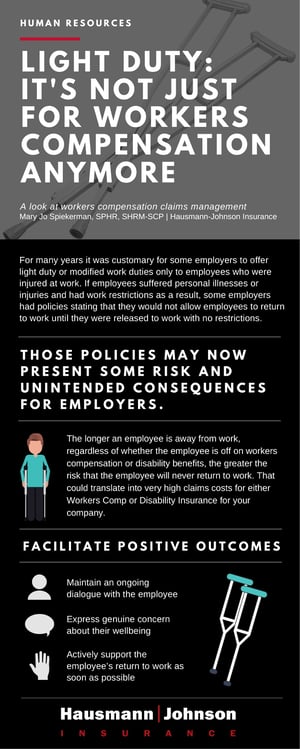One of the first things we learn when we become involved in workers compensation claims management is the importance of returning the injured employee to work as soon as possible. While medical costs associated with the injury do impact your workers compensation loss ratio, lost time has a significantly higher negative impact.
So what we have learned is to make every effort to return the employee to work quickly and to find work for them  within any restrictions their doctor might give us. We call that "light duty". This might involve temporarily eliminating or modifying job duties in the employee’s existing job or temporarily offering them a completely different job that conforms to their work restrictions.
within any restrictions their doctor might give us. We call that "light duty". This might involve temporarily eliminating or modifying job duties in the employee’s existing job or temporarily offering them a completely different job that conforms to their work restrictions.
For many years it was customary for some employers to offer light duty or modified work duties only to employees who were injured at work. If employees suffered personal illnesses or injuries and had work restrictions as a result, some employers had policies stating that they would not allow employees to return to work until they were released to work with no restrictions.
Those policies may now present some risk and unintended consequences for employers.
The Americans with Disabilities Act (ADA) obligates employers to work cooperatively with employees who have disabilities. It requires that employers engage in an “interactive process” with those employees and attempt to make accommodations to allow them to continue to work. An accommodation may be to allow modified work duties or hours. There are also additional protections afforded to disabled workers in Wisconsin under the Wisconsin Fair Employment Act (WFEA).
Let's use a simple example:
Assume that you had a warehouse employee "Fred" who fell at work and broke his leg. He returned to work after an absence of two days with a requirement that he was to work seated for four weeks. You accommodated that by assigning him to work in your office taking telephone orders until he was released by his doctor to return to his former job in the warehouse with no restrictions.
Now let's say you have a warehouse employee "John" who is diagnosed with bone cancer and has to have surgery on his leg. He is released to return to work with a requirement that he is to work seated for four weeks. Let’s also say that you had a policy that you only allow employees with non-work related illnesses or injuries to return to work when they are released to work with no restrictions. Therefore you did not offer John the sedentary work you offered Fred. In that situation your actions might be viewed as discriminatory toward individuals with disabilities (not accommodating a person with cancer while accommodating an individual without a disability in the example we used) and that you failed to engage in the interactive process with a disabled employee (cancer being a disability) who was released to work in some capacity.
Certainly not all employees have disabilities as protected under ADA or WFEA and some truly do have temporary illnesses and injuries. In those cases, not allowing employees to work when they are released with restrictions may result in increased short term disability costs if you have that coverage. Also, it is well known that the longer an employee is away from work, regardless of whether the employee is off on workers compensation or disability benefits, the greater the risk that the employee will never return to work. That could translate into very high claims costs for either Workers Comp or Disability Insurance for your company.
Finally, having different policies in accommodating work restrictions when they are due to workers compensation or personal disability may result in employee relations issues. Employees may perceive that the employer is willing to accommodate restrictions when it is in the employer's interest (a workers compensation claim) but not when it is in the employee's interest (a personal illness.) There are few employers who would want that reputation.
Regardless of how the illness or injury arose, maintaining an ongoing dialogue with the employee, expressing genuine concern about their wellbeing, and actively supporting the employee’s return to work as soon as possible will go a long way toward positive outcomes for both your company and the employee.
Are you looking for ideas for Light Duty at your organization? Download our list for some suggestions:

COMMENTS